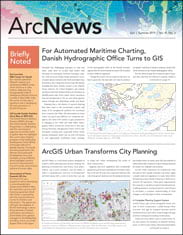Shoreline erosion is a significant problem that impacts communities’ ability to protect natural resources and public infrastructure, as well as support tourism, energy, and defense. To better manage nonenergy marine minerals like sand and gravel along the nation’s outer continental shelf (OCS), the US Bureau of Ocean Energy Management’s (BOEM) Marine Minerals Program created a new GIS solution that combines current and historical data.
The project—called the Marine Minerals Information System (MMIS)—was developed by BOEM in collaboration with the National Oceanic and Atmospheric Administration (NOAA), the Bureau of Safety and Environmental Enforcement (BSEE), and the US Department of the Interior to support public policy decision-making; improve the integrity of BOEM resource management and leasing oversight; increase coastal resilience; and reduce response time, especially after extreme coastal storms.

BOEM had accumulated more than three decades’ worth of marine minerals data and documentation on a project-by-project basis but was hampered by the lack of a centralized system for managing geospatial information. The agency contracted with Esri partner Quantum Spatial, Inc. (QSI), to develop the MMIS, an enterprise GIS (eGIS) solution that now serves as the central authoritative system of record for available ocean sand and minerals geospatial data and nongeospatial documentation.
Making Sense of Complex, Diverse Data
Creating the MMIS, which began in 2014, was a formidable task. It covered the OCS along the US federal waters of Alaska, the Pacific and Atlantic Oceans, and the Gulf of Mexico. Other challenges included the scope and volume of information, variable data formats, and the number and type of data sources that QSI had to incorporate into the eGIS. QSI also needed to coalesce all available data into a standardized data model, then develop tools for viewing, analyzing, and managing the MMIS data.
To start, QSI outlined the complex data needs for the MMIS, which included the following:
- Accurately capturing the characteristics of the seafloor
- Quantifying and delineating what was known about offshore sediment materials
- Understanding details such as the location, extent, and volume of offshore marine minerals, as well as their specific characteristics, including grain size, texture, Munsell color, and soil classification
- Incorporating historical data and documentation on extraction, leasing, and deposition activities to ensure that future activities are orchestrated and based on reliable information
After assessing BOEM’s IT capabilities and evaluating security requirements, the team at QSI determined that the system should be built leveraging Esri technology, which BOEM users were already familiar with. QSI designed the system architecture based on BOEM’s needs and Esri best practices.
The MMIS uses the ArcGIS platform, including ArcGIS Enterprise, ArcSDE with Microsoft SQL Server, and ArcGIS Desktop, as well as a custom desktop tool for matching source material from the OCS to the beach and a public-facing online viewer, built with Leaflet, that consumes web services hosted in ArcGIS Enterprise. The system is a robust relational geodatabase that is designed to be continuously populated by data from BOEM marine minerals scientists and provide all users with the ability to access relevant documents geospatially and visualize information for BOEM’s active and past projects.
After designing the MMIS, QSI identified, collected, organized, evaluated, and incorporated 150,000 digital data assets, as well as nondigital documents with associated metadata, into the eGIS. This data represented more than 30 years of records collected and/or cataloged by myriad agencies and entities, including BOEM; the US Army Corps of Engineers; the US Geological Survey; universities; state survey offices; and other programs such as cooperative agreements, sand lease projects, and environmental studies.
Since data from disparate sources is rarely standardized, QSI then had to address the variables in accuracy, comprehensiveness, resolution, spatial and temporal scale, and geospatial nature. The company created a standardized data model using case studies and Esri’s 10-step guide for designing geodatabases to structure, manage, and maintain spatial data in the MMIS geodatabase.

QSI combined elements of multiple scientific datasets and standards into a new comprehensive schema that could be used for all types of offshore sand and gravel data, meeting BOEM’s needs. In building the data model, QSI populated the database for different pilot areas as well to identify gaps or shortcomings in its schema. This enabled the company to normalize the data model for universal functionality.
Turning Data into Usable Insights
To extend the MMIS’s usability and functionality, QSI developed tools for users that enable sophisticated viewing, analysis, queries, reporting, and exploration of the data. The goal was to facilitate more effective communication among federal and state partners as they manage offshore mineral resources.
The tools that QSI built include the following:
- SediSearch (Sediment Search): This Python-built add-in to ArcGIS Desktop enables users to efficiently search and match marine resource material attributes—such as available volume, grain size, texture, classification, and color—to the needs or characteristics of an onshore beach or other coastal site that’s deprived of nourishment. SediSearch was designed to provide assurance that the offshore-to-onshore transfer of marine materials will ultimately result in identifying compatible sediment materials for shoreline protection, the restoration of beaches and wetlands, and effective shoreline construction projects.
- A web viewer: This is a custom web app for viewing, analyzing, and downloading data from the MMIS. It is an unrestricted version of MMIS that enables users from outside BOEM to obtain marine minerals information that they can use to plan activities led by states and local agencies. Key MMIS features in this publicly accessible app include
- More than 30 years of BOEM-funded geologic and geophysical research data
- Data from over 40 partners in federal, state, and local government; academia; and other entities
- A viewer with more than 20 data layers
- The offshore sediment data for 18 coastal states
- GIS mapping capabilities
- Tools to download data into geodatabases, shapefiles, or .csv files
- Statistics on the volume of sand dredged from the OCS, the number of active projects being managed by BOEM, the number of projects by state, and the miles of shoreline restored by state
- Links to environmental studies and assessments
- A dashboard: Built using Operations Dashboard for ArcGIS, this tool enables users to monitor and visually track project activities on a national, state, or local level. The dashboard contains information dating back 24 years and provides quick insights on miles of restored coastline, the total number of leases executed, and the total volume of sand allocated to specific areas. The dashboard has been embedded within BOEM’s public-facing website, providing answers to the many questions the agency receives about the Marine Minerals Program.
Delivering Results
The MMIS and its related interactive viewer tools have enabled BOEM to save time and money by keeping data in a ready state for scientists and the public to use whenever the need arises. In addition, the standardized data and analytical capabilities are supporting forthcoming resource planning and decision-making. It is also helping to resolve marine use conflicts—such as submarine cables being laid over viable sand resources; the accidental capture of endangered marine fish, sea turtles, or other wildlife; and the protection of archaeological sites within federal waters—and will likely aid in preventing future conflicts. Additionally, the standardized data is providing reliable shared access to marine minerals information that will assist with coordinating responsible management far into the future.
By delivering new, authoritative, and accurate data sources that agency officials, planners, contractors, scientists, and citizens can use to make informed decisions, the MMIS enhances the public’s faith in how valuable geospatial data is for public policy. It also gives stakeholders and the general public greater confidence in BOEM’s performance and accountability in negotiating lease agreements for the OCS.
For more information, email Cherie Jarvis, the eGIS practice lead at QSI, at cjarvis@quantumspatial.com.


